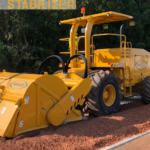Railway Track Road Stabilization
Focusing on the railway track road ballast issue, (oversize rock to 2” that is hard to compact, we need fines to make a compactable mix to stabilize). It is cost prohibitive to bring in new aggregate when there is a Global alternative.
Where does the ballast rock come from, why use it? The ballast rock is placed when a new rail track is placed, or maintenance. It is dropped between the rails and ties, to hold the rails and ties in place. The ballast then falls onto the roads and as a matter of convenience they simply use it for road rock. This is what needs correction, by converting the ballast in place to a usable aggregate for compaction and long-term road stability.
The focus is on financial savings by using onsite aggregates, to reduce their size with our rotary mixer and combine that reduction with other aggregate and native soils. Additionally, this process of stabilizing to a 5” depth creates a very long-term solution eliminating the constant topical maintenance applications annually or semiannually.
Each time we must go into the track roads, rail traffic for safety reasons and must be directed to alternate tracks and reduces the available tracks for them to combine loads going to different locations and slows down the daily work. So, if we are going to go into the closed off-track roads, let’s do a long-term fix.
Option #1
Grade, mix existing different sized aggregates, compact existing track roads, and apply a topical Earthbind® application. Not a long-term fix but better than just apply EB on big ballast rock.
Option #2
Mechanically rotary mix to the 5” depth breaking down the larger aggregate to mix with smaller aggregate and native soils for an excellent mix for compaction. Then inject Earthbind® into the top 5” in prepared road finish grade and compact. This protocol will last for many years eliminating constant annual maintenance. This is as close to paving at a fraction of hot asphalt paving.






